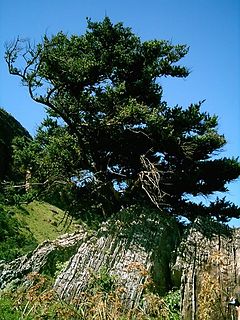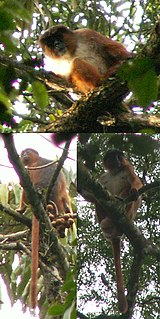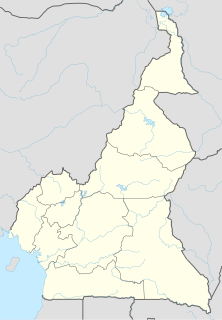
The Bakossi Forest Reserve is a 5,517 square kilometres (2,130 sq mi) reserve within the Bakossi Mountains in Cameroon, home to many rare species of plants, animals and birds. [1] The Forest Reserve in turn contains the Bakossi National Park, created by a decree in early 2008. The park covers 29,320 hectares (72,500 acres), and was justified on the basis of preserving plant diversification. [2]
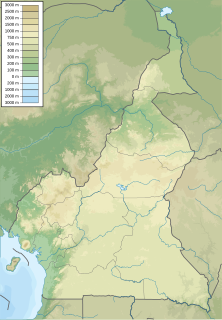
The Bakossi Mountains are a mountain range that forms part of the Cameroon line of active and extinct volcanoes in western Cameroon, covering about 230,000 square kilometres (89,000 sq mi). The mountains lie in the regions of Littoral and the Southwest. The highest peak in this range is Mount Kupe at 2,064 metres (6,772 ft). They contain a large area of cloud forest, and have considerable ecological interest. The mountains are home to the Bakossi people.

Cameroon, officially the Republic of Cameroon, is a country in Central Africa. It is bordered by Nigeria to the west and north; Chad to the northeast; the Central African Republic to the east; and Equatorial Guinea, Gabon and the Republic of the Congo to the south. Cameroon's coastline lies on the Bight of Biafra, part of the Gulf of Guinea and the Atlantic Ocean. Although Cameroon is not an ECOWAS member state, it geographically and historically is in West Africa with the Southern Cameroons which now form her Northwest and Southwest Regions having a strong West African history. The country is sometimes identified as West African and other times as Central African due to its strategic position at the crossroads between West and Central Africa.

The Bakossi National Park (BNP) is a protected area within the Bakossi Forest Reserve, created by a decree in early 2008. The park covers 29,320 hectares, and was justified on the basis of preserving plant diversification.
The Bakossi Mountains, which include Mount Kupe, cover in total about 230,000 square kilometres (89,000 sq mi), with perhaps the largest area of cloud forest in West-Central Africa. [3] They are part of a larger tract of forest that extends northward into the western foothills of the Bamboutos Mountains. [4] The reserve was created in 1956. In 2000, the main section of the reserve was designated a protection forest. All logging was banned and Kupe became a "strict nature reserve". The local Bakossi people participated in delineating the boundaries. [1] Between 2003 and 2007, the effectiveness of management in this and other parks improved greatly, although the local people were not well integrated into the system, and lacked education and awareness of environmental goals. [5]

Mount Kupe or Mont Koupé is a plutonic mountain in the Western High Plateau of Cameroon, part of the Cameroon line of volcanoes. It is the highest of the Bakossi mountains, rising to 2,064 metres (6,772 ft).

A cloud forest, also called a water forest and primas forest, is a generally tropical or subtropical, evergreen, montane, moist forest characterized by a persistent, frequent or seasonal low-level cloud cover, usually at the canopy level, formally described in the International Cloud Atlas (2017) as silvagenitus. Cloud forests often exhibit an abundance of mosses covering the ground and vegetation, in which case they are also referred to as mossy forests. Mossy forests usually develop on the saddles of mountains, where moisture introduced by settling clouds is more effectively retained.
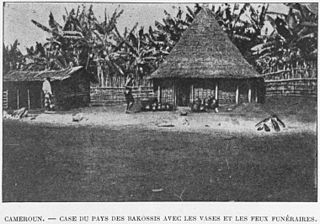
The Bakossi people live on the western and eastern slopes of Mount Mwanenguba and Mount Kupe in the Bakossi Mountains of Cameroon. They number about 200,000, mostly engaged in subsistence farming but also producing some coffee and cocoa.
The mountains have one of the healthiest remaining populations of the endangered drill, a primate related to the mandrill. [6] The drill population in Bakossiland has been threatened by hunters in the area. Drills became extinct in the late 1970s in the Loum Forest Reserve, and may be extinct on Mount Mwanenguba. However, since 1994, on Mount Kupe the drill population has started to recover due to protection from the Bakossi traditional chiefs. [7] Other primates are Preuss's monkey, red-eared guenon, greater spot-nosed monkey and several species of bush baby, collared mangabey, chimpanzee and Preuss's red colobus. Some of the species of chameleon are thought to be found only in the region. The area has many species of bird. On Mount Kupe alone, more than 329 species have been recorded. These include the Mount Kupe bushshrike, the endangered white-throated mountain babbler, and the vulnerable green-breasted bushshrike and grey-necked picathartes. [6]

The mandrill is a primate of the Old World monkey (Cercopithecidae) family. It is one of two species assigned to the genus Mandrillus, along with the drill. Both the mandrill and the drill were once classified as baboons in the genus Papio, but they now have their own genus, Mandrillus. Although they look superficially like baboons, they are more closely related to Cercocebus mangabeys. Mandrills are found in southern Cameroon, Gabon, Equatorial Guinea, and Congo. Mandrills mostly live in tropical rainforests. They live in very large groups. Mandrills have an omnivorous diet consisting mostly of fruits and insects. Their mating season peaks in July to September, with a corresponding birth peak in December to April.
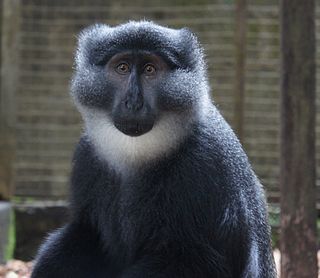
The Preuss's monkey, also known as Preuss's guenon, is a diurnal primate that lives terrestrially in mountainous forests of eastern Nigeria, western Cameroon and Bioko in Equatorial Guinea. It is sometimes classified as a subspecies of the L'Hoest's monkey.

The red-eared guenon, red-eared monkey, or russet-eared guenon is a species of primate in the family Cercopithecidae. It is found in Cameroon, Equatorial Guinea, and Nigeria. Its natural habitat is subtropical or tropical moist lowland forests. It is threatened by habitat loss, illegal bushmeat hunting and pet trade.



